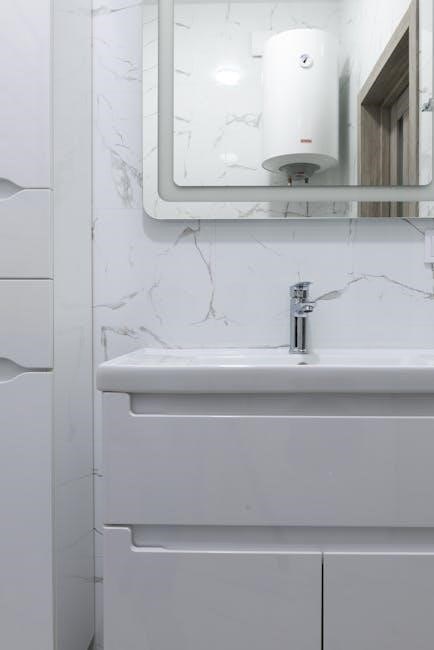Space Saver Water Heater Manual: A Comprehensive Guide
Welcome to the comprehensive guide for your Space Saver water heater! This manual provides essential information on installation‚ operation‚ and maintenance to ensure optimal performance. We aim to equip you with the knowledge needed for safe and efficient use.
Space Saver water heaters are designed for homes and apartments where space is limited. These units offer a compact footprint without compromising hot water availability. Brands like GSW‚ A.O. Smith‚ and John Wood provide various models tailored to different needs. These heaters utilize electric power for efficient heating and are easy to install.
Their design minimizes energy loss and maximizes hot water consumption. Space Saver models often feature internal thermostats and safety mechanisms to prevent overheating and ensure safe operation. Understanding the specific features of your model is crucial for optimal performance and longevity.
This manual will guide you through the installation process‚ thermostat settings‚ troubleshooting common issues‚ and maintenance tips. Whether you’re a homeowner or a professional installer‚ this comprehensive guide will provide the necessary information to get the most out of your Space Saver water heater. Prioritizing safety and adhering to the manufacturer’s instructions will ensure years of reliable hot water supply.
Remember to consult the specific instructions provided by your model’s manufacturer‚ as details can vary.
Understanding Your Space Saver Model
Before proceeding with installation or troubleshooting‚ it’s crucial to understand the specifics of your Space Saver water heater model. Locate the model number and serial number‚ typically found on a label attached to the unit. This information will be essential for accessing the correct documentation and replacement parts.
Note the tank capacity‚ which indicates the amount of hot water the heater can store. Space Saver models come in various sizes‚ ranging from small point-of-use heaters to larger units suitable for multiple fixtures. Identify the voltage and wattage requirements to ensure compatibility with your electrical system.
Familiarize yourself with the location of key components such as the thermostat‚ heating elements‚ and drain valve. Understanding their function will aid in troubleshooting potential issues. Review the manufacturer’s specifications regarding water pressure and temperature settings. Over exceeding these limits can affect performance.
Also‚ pay attention to any specific installation instructions provided for your particular model. Some models may require unique mounting configurations or plumbing connections. By thoroughly understanding your Space Saver water heater‚ you can ensure proper installation‚ efficient operation‚ and effective maintenance. This proactive approach will contribute to the unit’s longevity.
Safety Precautions Before Installation
Prior to commencing any installation work on your Space Saver water heater‚ prioritizing safety is paramount. Begin by disconnecting the electrical power supply to the intended circuit at the breaker panel. Verify the power is off using a reliable voltage tester. Never work on electrical components without confirming the absence of power.
Ensure the area surrounding the installation site is clear of flammable materials‚ such as gasoline‚ paints‚ or cleaning solvents. Adequate ventilation is also crucial to prevent the build-up of fumes during the installation process. Wear appropriate personal protective equipment‚ including safety glasses and gloves‚ to protect against potential hazards.

Inspect the water heater for any signs of damage before installation. Do not install a damaged unit. Verify that the water pipes are properly grounded to prevent electrical shock. Be mindful of the weight of the water heater. Use proper lifting techniques or seek assistance when moving the unit to avoid injuries.
If you are not comfortable performing any of these steps‚ consult a qualified plumber or electrician. Improper installation can lead to water damage‚ electrical hazards‚ or void the manufacturer’s warranty. Following these safety precautions will help ensure a safe and successful installation process. Always refer to local codes.
Step-by-Step Installation Guide
Begin by carefully unpacking your Space Saver water heater and verifying all components are present. Consult the parts list in this manual. Choose a suitable location that provides easy access for future maintenance and is near water and electrical connections. Ensure the floor is level and capable of supporting the filled water heater’s weight.
First‚ install the temperature and pressure relief valve (T&P valve) according to local plumbing codes. This valve is crucial for safety. Connect the drain line from the T&P valve to a suitable drain‚ ensuring it slopes downward and terminates at least six inches above the floor drain.
Next‚ connect the water pipes to the inlet and outlet fittings on the water heater. Use Teflon tape or pipe dope on all threaded connections to prevent leaks. Ensure the cold water inlet pipe has a shut-off valve installed for easy maintenance. Before turning on the water‚ open a hot water faucet to allow air to escape from the tank.
Finally‚ connect the electrical wiring according to local electrical codes. Use the correct gauge wire and ensure proper grounding. Once all connections are complete‚ turn on the water supply and check for leaks. Then‚ turn on the electrical breaker to power the water heater. Monitor the water heater for proper operation.
Connecting to Water and Electrical Mains
Connecting your Space Saver water heater to the water mains requires careful attention to detail to ensure a safe and leak-free installation. Begin by identifying the cold water inlet and hot water outlet on the unit. Use appropriately sized pipes‚ preferably copper or PEX‚ to connect to your existing plumbing. Apply Teflon tape to all threaded connections to create a watertight seal. It’s crucial to install a shut-off valve on the cold water inlet line for future maintenance or repairs.
When connecting to the electrical mains‚ safety is paramount. Ensure the power is turned off at the breaker before commencing any electrical work. Refer to the wiring diagram in this manual to correctly connect the wires. Typically‚ you’ll have a black (hot)‚ white (neutral)‚ and green (ground) wire. Use appropriately sized electrical wire based on the water heater’s voltage and amperage requirements. Securely connect the wires using wire connectors and ensure all connections are tight. Grounding is essential for safety and preventing electrical shock.
After completing both water and electrical connections‚ carefully inspect all fittings and connections for leaks or loose wires. Turn the water supply back on slowly and check for any leaks around the pipe connections. Once you’re confident that there are no leaks‚ turn the power back on at the breaker and monitor the water heater for proper operation.
Thermostat Settings and Temperature Adjustment
The thermostat on your Space Saver water heater controls the water temperature‚ influencing both comfort and energy consumption. Understanding how to adjust the thermostat is key to optimizing your water heating experience. Locate the thermostat access panel‚ typically found behind a removable cover on the front or side of the unit. Before making any adjustments‚ turn off the power to the water heater at the breaker to prevent electrical shock.
Once the power is off‚ carefully remove the access panel to reveal the thermostat. You’ll usually find a dial or adjustment screw with temperature markings. Most manufacturers recommend a setting of 120°F (49°C) for residential use. This temperature is hot enough for most needs while minimizing the risk of scalding. To adjust the temperature‚ use a screwdriver or dial to set the desired temperature.
After making the adjustment‚ replace the access panel securely and turn the power back on at the breaker. Allow several hours for the water to heat up to the new setting. Monitor the water temperature at your faucets to ensure it aligns with your desired setting. If necessary‚ repeat the adjustment process until you achieve the perfect balance of comfort and energy efficiency. Remember to always prioritize safety and avoid setting the temperature too high‚ especially in households with children or elderly individuals.
Troubleshooting Common Issues
Even with proper installation and maintenance‚ you might encounter occasional issues with your Space Saver water heater. This section outlines common problems and provides troubleshooting steps to help you resolve them. One frequent issue is a lack of hot water. First‚ check the circuit breaker to ensure the water heater is receiving power. If the breaker has tripped‚ reset it. If it trips again immediately‚ there may be an electrical problem requiring professional attention.
Another common problem is water that’s not hot enough. Verify that the thermostat is set to the desired temperature (typically 120°F/49°C). If the thermostat is correctly set‚ the heating element might be faulty and need replacement. Leaks are another concern. Check all connections for tightness. If a connection is leaking‚ tighten it carefully. If the leak persists‚ or if the tank itself is leaking‚ it’s time to call a qualified plumber.
Strange noises‚ like rumbling or popping‚ often indicate sediment buildup in the tank. Flushing the tank regularly can prevent this. Finally‚ if you notice discolored or rusty water‚ it could indicate corrosion inside the tank. In this case‚ it’s best to consult with a professional to assess the extent of the damage and determine the best course of action‚ which may involve replacing the water heater. Always prioritize safety when troubleshooting electrical or plumbing issues.
Maintenance Tips for Longevity
Proper maintenance is crucial for extending the life of your Space Saver water heater and ensuring efficient operation. One of the most important maintenance tasks is flushing the tank annually to remove sediment buildup. Sediment accumulation reduces heating efficiency and can damage the tank. To flush the tank‚ turn off the power and water supply‚ attach a hose to the drain valve at the bottom of the tank‚ and open the valve to drain the water.
Regularly inspect the anode rod‚ which protects the tank from corrosion. The anode rod sacrifices itself to protect the tank‚ so it will eventually need replacement. Check the rod every few years and replace it when it’s significantly corroded. Also‚ inspect the temperature and pressure (T&P) relief valve annually. To test it‚ lift the lever and ensure water flows freely. If it doesn’t‚ or if it leaks afterward‚ replace the valve.

Insulating the water heater can also improve efficiency and reduce energy costs. Consider adding an insulation blanket‚ especially if the tank is located in an unheated area. Finally‚ periodically check the plumbing connections for leaks and address them promptly to prevent water damage. By following these simple maintenance tips‚ you can significantly extend the lifespan of your Space Saver water heater and ensure years of reliable hot water service.
Understanding the Warranty
Your Space Saver water heater comes with a warranty that protects you against manufacturing defects and premature failure. It is essential to understand the terms and conditions of the warranty to ensure you are covered in case of any issues. The warranty typically covers the tank and component parts for a specified period‚ usually ranging from six to ten years.
However‚ the warranty may be voided if the water heater is not installed according to the manufacturer’s instructions or if it is subjected to misuse or abuse. Proper installation‚ including adequate grounding and adherence to plumbing codes‚ is crucial for maintaining warranty coverage. Additionally‚ regular maintenance‚ such as flushing the tank and replacing the anode rod‚ is often required to keep the warranty valid.
To make a warranty claim‚ you will typically need to provide proof of purchase‚ such as a sales receipt‚ and documentation of any maintenance performed. Contact the manufacturer or an authorized service representative to initiate the claim process. Be sure to keep all records related to your water heater‚ including installation documents‚ maintenance logs‚ and any repair invoices. Understanding your warranty and adhering to its requirements will ensure you receive the coverage you are entitled to should any problems arise with your Space Saver water heater.
GSW SpaceSaver Specific Instructions
GSW SpaceSaver water heaters‚ known for their Canadian heritage and innovative design‚ require specific installation and maintenance procedures to ensure optimal performance and longevity. These instructions are tailored to the unique features of GSW SpaceSaver models. Before commencing installation‚ carefully review the GSW SpaceSaver installation manual‚ paying close attention to the recommended clearances and electrical requirements.
GSW SpaceSaver models may have specific venting requirements‚ particularly for gas-powered units. Ensure proper venting to prevent the buildup of carbon monoxide. When connecting the water lines‚ use dielectric unions to prevent corrosion caused by dissimilar metals. Periodically inspect the anode rod and replace it as needed to protect the tank from rust. Flush the tank annually to remove sediment buildup‚ improving efficiency and extending the lifespan of the water heater.
For electric GSW SpaceSaver models‚ verify the correct voltage and amperage ratings before connecting to the electrical supply. Always disconnect the power before performing any maintenance or repairs. By following these GSW SpaceSaver specific instructions‚ you can ensure your water heater operates safely and efficiently‚ providing years of reliable hot water. Remember to consult the GSW SpaceSaver manual for complete details and troubleshooting tips.

A.O. Smith SpaceSaver Information
A.O. Smith‚ a trusted name in water heating solutions for over 70 years‚ offers a range of SpaceSaver water heaters designed for compact spaces without compromising performance. These models incorporate innovative features and require specific attention during installation and maintenance. Prior to installation‚ consult the A.O. Smith SpaceSaver manual for detailed instructions and safety precautions. Verify the model number and ensure compatibility with your plumbing and electrical systems.
A.O. Smith SpaceSaver water heaters often feature advanced control systems and energy-saving technologies. Familiarize yourself with the thermostat settings and temperature adjustment procedures to optimize energy efficiency and prevent scalding. Regularly inspect the pressure relief valve and drain valve for proper operation. Sediment buildup can reduce efficiency and lifespan; therefore‚ periodic flushing is essential.
When replacing parts‚ use only genuine A.O; Smith replacement parts to maintain warranty coverage and ensure proper functionality. A.O. Smith offers a variety of resources‚ including online manuals and customer support‚ to assist with troubleshooting and maintenance. By following these specific guidelines and consulting the A.O. Smith SpaceSaver manual‚ you can ensure your water heater provides reliable hot water for years to come. Remember safety precautions and proper installation are key.
John Wood SpaceSaver Information
John Wood offers reliable SpaceSaver water heaters tailored for homes needing efficient hot water solutions in limited spaces. These units‚ known for their durability‚ require specific installation and maintenance protocols detailed in the John Wood SpaceSaver manual. Before installing‚ carefully review the manual‚ noting the model-specific requirements for plumbing and electrical connections. Ensure compliance with local codes.
John Wood SpaceSaver models often feature unique design elements that maximize space utilization. Understanding the specific features of your model is crucial for optimal performance. Pay close attention to the manual’s instructions regarding thermostat settings and temperature adjustments to prevent overheating and conserve energy. Regular maintenance‚ including flushing sediment and inspecting the anode rod‚ is vital for extending the lifespan of your John Wood SpaceSaver water heater.

When sourcing replacement parts‚ prioritize genuine John Wood components to maintain warranty validity and ensure compatibility. John Wood provides comprehensive resources‚ including online manuals and customer support‚ to assist with troubleshooting and maintenance inquiries. Adhering to these guidelines and consulting the John Wood SpaceSaver manual will help guarantee the long-term reliability and efficiency of your water heater. Prioritize safety during installation and maintenance procedures. Remember to disconnect power before any repairs.
Locating Replacement Parts and Manuals
Finding the correct replacement parts and manuals for your Space Saver water heater is crucial for proper maintenance and repairs. Start by identifying the exact model number of your unit‚ typically located on a label affixed to the heater’s exterior. With the model number‚ visit the manufacturer’s website (GSW‚ A.O. Smith‚ or John Wood) to access digital manuals. Many manufacturers offer downloadable PDFs of their product manuals‚ providing detailed diagrams and part lists.
For physical replacement parts‚ consider authorized dealers or reputable online retailers specializing in water heater components. Ensure the parts are compatible with your specific Space Saver model to guarantee proper fit and function. Refer to the parts list in your manual for accurate part numbers. Local plumbing supply stores may also carry common replacement parts.
If you encounter difficulty locating a specific manual or part‚ contact the manufacturer’s customer service department for assistance. They can often provide access to archived manuals or direct you to authorized suppliers. Be cautious when purchasing from unverified sources‚ as counterfeit or incompatible parts can damage your water heater and void the warranty. Always prioritize genuine replacement parts and consult the official manual for accurate installation instructions. Proper documentation and authentic components are essential for safe and effective repairs.
